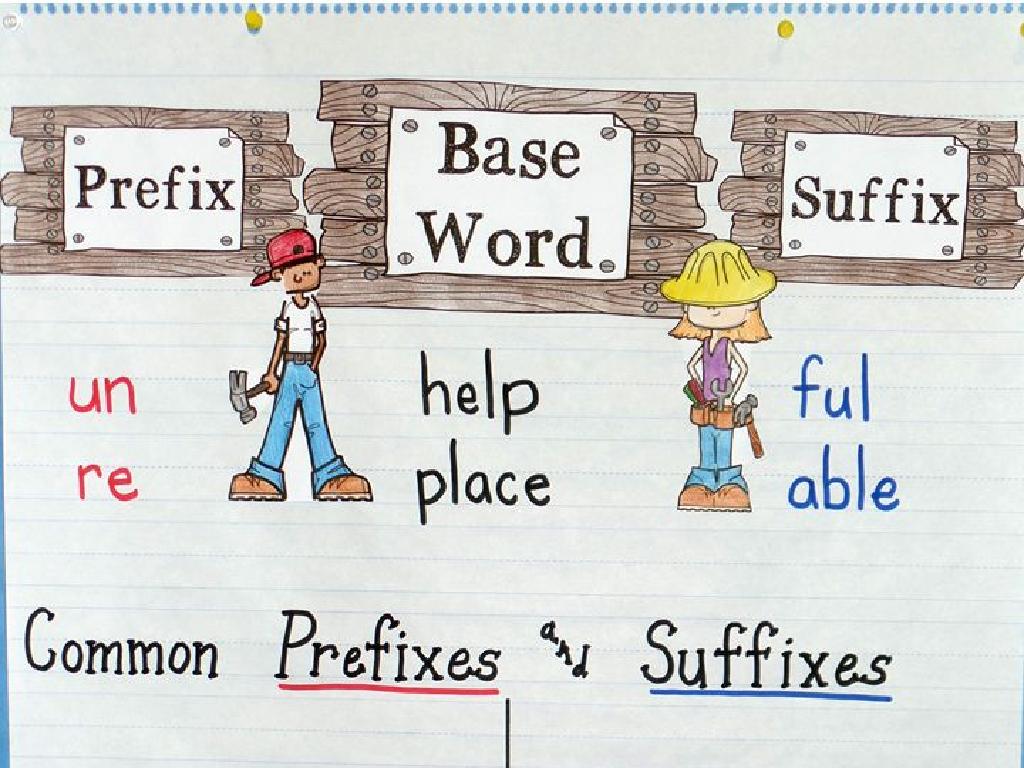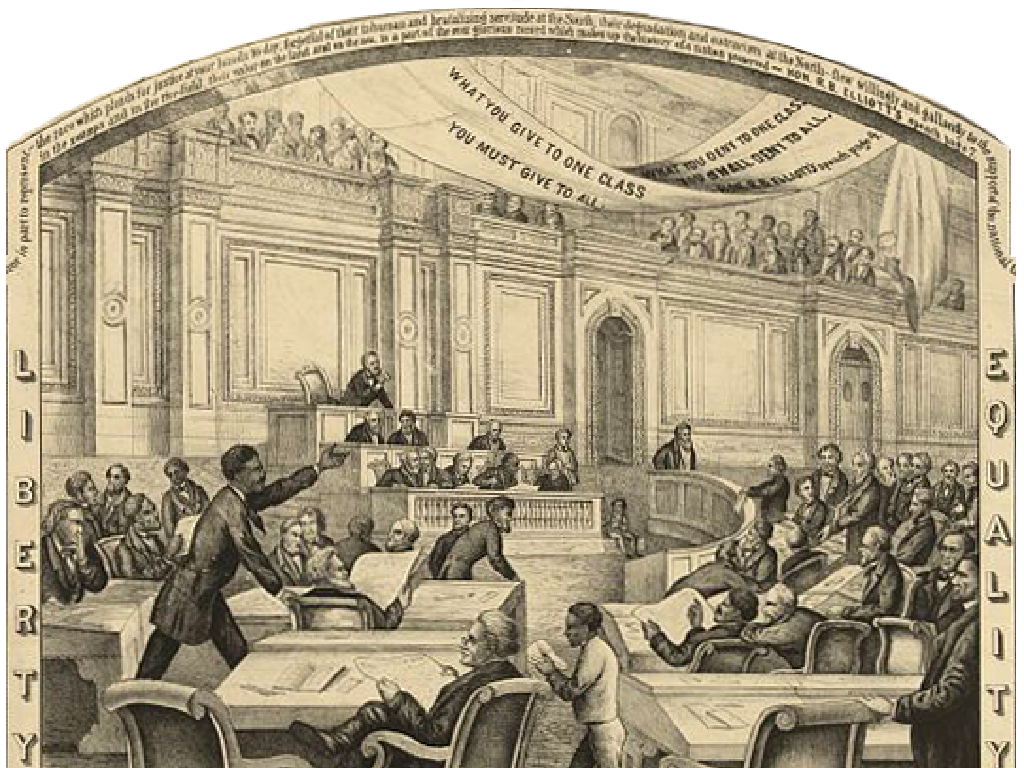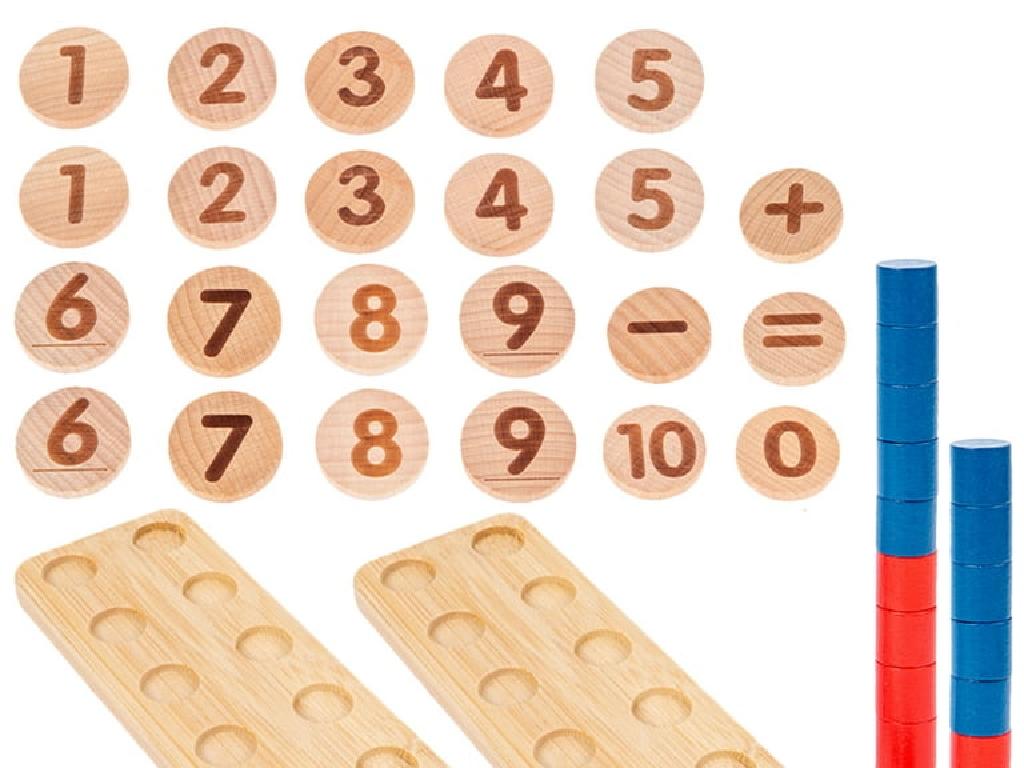Fractions Review
Subject: Math
Grade: Fifth grade
Topic: Fractions And Mixed Numbers
Please LOG IN to download the presentation. Access is available to registered users only.
View More Content
Welcome to Fractions!
– Exploring parts and wholes
– Understand objects can be divided into equal parts
– Recap: Fraction fundamentals
– A fraction represents a part of a whole
– Fractions in daily life
– Used in cooking, budgeting, and time management
– Practice with real examples
– Let’s cut a pizza into slices and share!
|
This slide introduces the concept of fractions by relating it to the students’ understanding of parts and wholes. Begin by discussing how everyday objects can be divided into equal parts, which leads to the fundamental definition of a fraction. Emphasize the importance of fractions in daily life, such as in cooking (measuring ingredients), budgeting (dividing money), and managing time (understanding hours and minutes). Engage students with practical examples, like sharing a pizza, to make the concept more relatable and easier to grasp. Encourage students to think of other examples where they use fractions without realizing it. This will help them see the relevance of fractions beyond the classroom.
Understanding Parts of a Fraction
– Numerator: Parts we have
– The top number in a fraction, e.g., in 3/4, 3 is the numerator
– Denominator: Total parts
– The bottom number in a fraction, e.g., in 3/4, 4 is the denominator
– Everyday fractions examples
– Pizza slices, measuring cups, and money (quarters)
– Practice identifying parts
|
This slide introduces the basic components of a fraction: the numerator and the denominator. The numerator, located at the top, indicates how many parts of a whole we are considering, while the denominator, at the bottom, shows the total number of equal parts that make up the whole. To help students grasp the concept, use relatable examples such as slices of pizza to represent fractions of a whole pizza, or quarters to represent fractions of a dollar. Encourage students to bring in their own examples of fractions from their daily lives. The slide aims to solidify their understanding of fractions by identifying and practicing with real-world examples.
Types of Fractions
– Proper fractions: smaller numerator
– Numerator < Denominator, e.g., 3/4
– Improper fractions: larger numerator
– Numerator e Denominator, e.g., 5/3
– Mixed numbers: whole + fraction
– Combination of a whole number and a fraction, e.g., 1 2/3
– Converting between types
– Learn to change improper fractions to mixed numbers and vice versa
|
This slide introduces students to the different types of fractions. Proper fractions have a numerator smaller than the denominator, representing a part of a whole. Improper fractions have a numerator that is larger than or equal to the denominator, which can also be expressed as a mixed number a combination of a whole number and a proper fraction. It’s crucial for students to understand these concepts as they form the basis for operations with fractions. Provide examples for each type and demonstrate how to convert an improper fraction to a mixed number and back. This will prepare them for adding, subtracting, multiplying, and dividing fractions.
Converting Improper Fractions to Mixed Numbers
– Divide numerator by denominator
– Quotient becomes the whole number
– Remainder is the new numerator
– Example: Convert 7/4 to mixed number
– 7 divided by 4 equals 1 with a remainder of 3. So, 7/4 is 1 3/4.
|
This slide focuses on teaching students how to convert improper fractions, where the numerator is larger than the denominator, into mixed numbers. Start by dividing the numerator by the denominator to find the whole number part of the mixed number. The remainder of this division becomes the new numerator of the fractional part. For example, when converting 7/4, divide 7 by 4. The quotient is 1, which is the whole number, and the remainder is 3, which becomes the numerator of the fractional part, resulting in the mixed number 1 3/4. Encourage students to practice this method with various improper fractions to become comfortable with the process.
Understanding Equivalent Fractions
– What are equivalent fractions?
– Fractions that have the same value, but look different
– Multiplying to find equivalents
– Multiply the top and bottom by the same number, e.g., 1/2 x 2/2 = 2/4
– Dividing to find equivalents
– Divide the top and bottom by the same number, e.g., 4/8 ÷ 2/2 = 2/4
– Example: 1/2 equals 2/4
|
This slide introduces the concept of equivalent fractions, which are different fractions that represent the same value. Emphasize that by multiplying or dividing the numerator and denominator by the same non-zero number, we can find an equivalent fraction. Use visual aids like fraction bars or circles to show that 1/2 and 2/4 cover the same amount of space, reinforcing the concept. Encourage students to practice with different numbers to find other equivalent fractions and understand that this is a key concept in simplifying fractions and solving fraction problems.
Adding and Subtracting Fractions
– Fractions must have the same denominator
– Find a common denominator
– A common denominator is a shared multiple of the original denominators
– Example: Add 1/4 to 2/4
– 1/4 + 2/4 equals 3/4 because the denominators are the same
– Practice with different denominators
– Try adding 1/3 and 1/6 by finding a common denominator
|
When adding or subtracting fractions, the denominators must be the same. This is because fractions represent parts of a whole, and we can only combine parts that are the same size. If the denominators are different, find a common denominator by identifying a number that both denominators can divide into evenly. Use the example of adding 1/4 and 2/4 to show that when the denominators are the same, you simply add the numerators. Then, challenge students to practice with fractions that have different denominators, guiding them to find a common denominator before combining the fractions. This will help solidify their understanding of equivalent fractions and the process of adding and subtracting them.
Multiplying Fractions
– Multiply the top numbers
– To find the product, multiply the numerators (top numbers) of the fractions.
– Multiply the bottom numbers
– Then, multiply the denominators (bottom numbers) to get the new denominator.
– Simplify the fraction if needed
– If the fraction can be reduced, divide the top and bottom by the same number.
– Practice with an example
– Let’s multiply 1/2 by 3/4 together.
|
When teaching multiplication of fractions, start by explaining that the numerators and denominators are multiplied separately. Emphasize that the new fraction may need to be simplified by finding the greatest common divisor for the numerator and denominator. Use the example of multiplying 1/2 by 3/4 to illustrate the process: (1×3)/(2×4) = 3/8. This example is simple and relatable for fifth graders, reinforcing the concept. Encourage students to work through additional examples and provide guidance on simplifying fractions. This slide should serve as a clear and concise introduction to multiplying fractions.
Dividing Fractions
– Flip the divisor to find reciprocal
– To divide by a fraction, turn it upside down
– Multiply by the reciprocal
– After flipping, multiply the first fraction by the new one
– Simplify the result if needed
– If the answer isn’t in simplest form, reduce it
– Practice with an example
– Let’s divide 1/2 by 3/4 together
|
When teaching division of fractions, start by explaining the concept of a reciprocal – flipping the numerator and denominator of the divisor. Emphasize that division by a fraction is the same as multiplication by its reciprocal. Walk through the process step by step, ensuring students understand each part. Use the example of dividing 1/2 by 3/4 to illustrate the process: flip 3/4 to get 4/3, then multiply 1/2 by 4/3 to get 4/6, which simplifies to 2/3. Encourage students to practice with additional examples and provide guidance on simplifying fractions.
Simplifying Fractions
– Find the GCD of numerator & denominator
– GCD of 8 and 12 is 4
– Divide both by the GCD to simplify
– 8 divided by 4 is 2, and 12 divided by 4 is 3
– Example: Simplify 8/12
– 8/12 simplifies to 2/3
|
When simplifying fractions, the goal is to make the fraction as simple as possible by finding the greatest common divisor (GCD) of the numerator and the denominator. The GCD is the largest number that divides both numbers without leaving a remainder. Once the GCD is found, both the numerator and the denominator should be divided by this number to simplify the fraction. For example, to simplify 8/12, we find that the GCD of 8 and 12 is 4. Dividing both by 4, we get 2/3, which is the simplified form of 8/12. Encourage students to practice this process with different fractions and to check their work by ensuring that the simplified fraction cannot be reduced any further.
Class Activity: Fraction Scavenger Hunt
– Find classroom items as fractions
– List items with their fractions
– Share your fractions with the class
– Discuss the fraction representations
|
This interactive activity is designed to help students apply their knowledge of fractions to real-world objects in their classroom. Students will search for items that can be divided into equal parts and represent them as fractions. For example, a pizza cut into 8 slices can be represented as 1/8 per slice. Encourage students to be creative in their search and think about how everyday objects can be quantified using fractions. After the hunt, students will create a list of the items they found and the corresponding fractions. Then, they will share their findings with the class, fostering a discussion about the different ways fractions can represent parts of a whole. This activity will reinforce their understanding of fractions and provide a foundation for learning mixed numbers.





